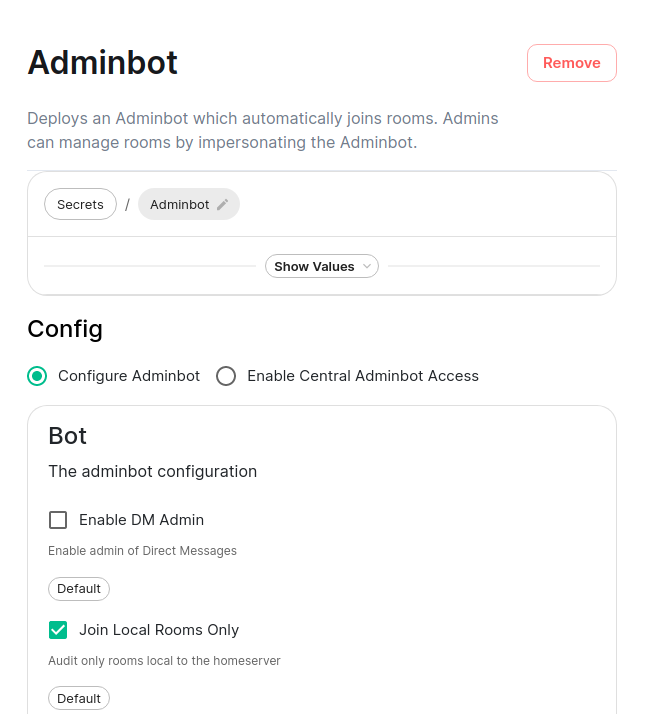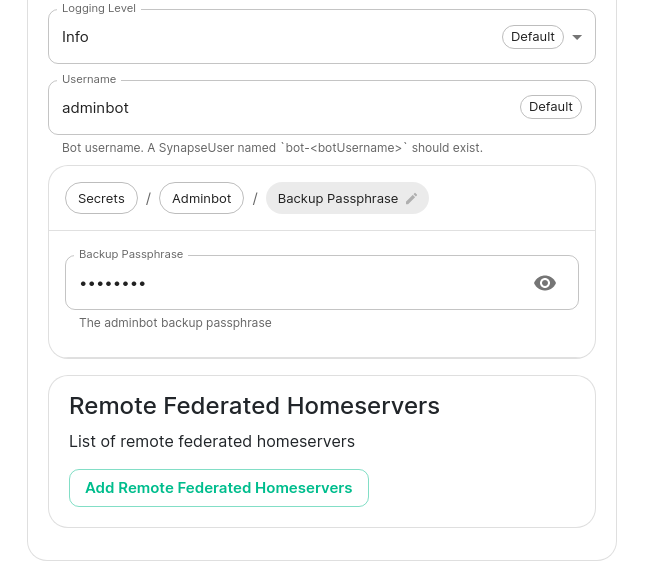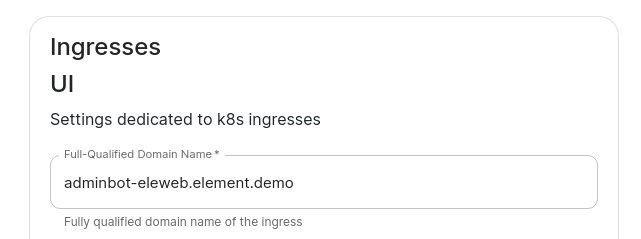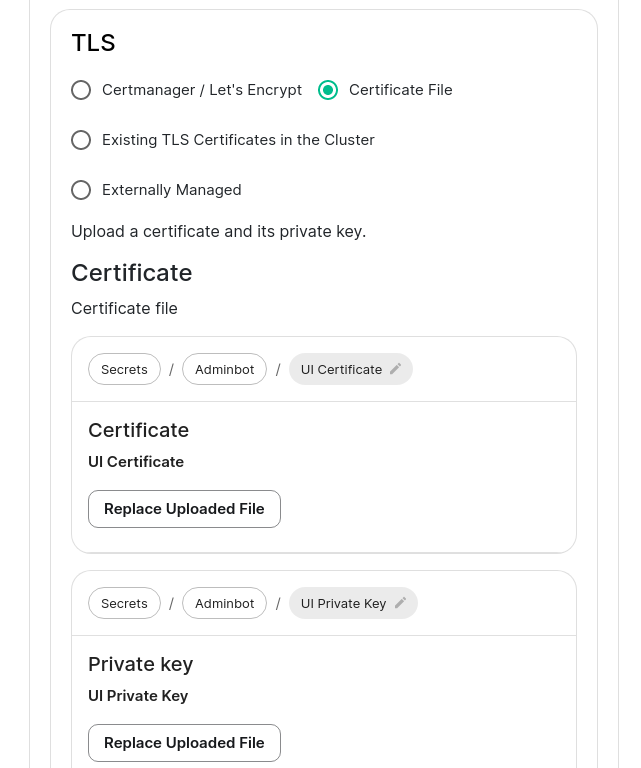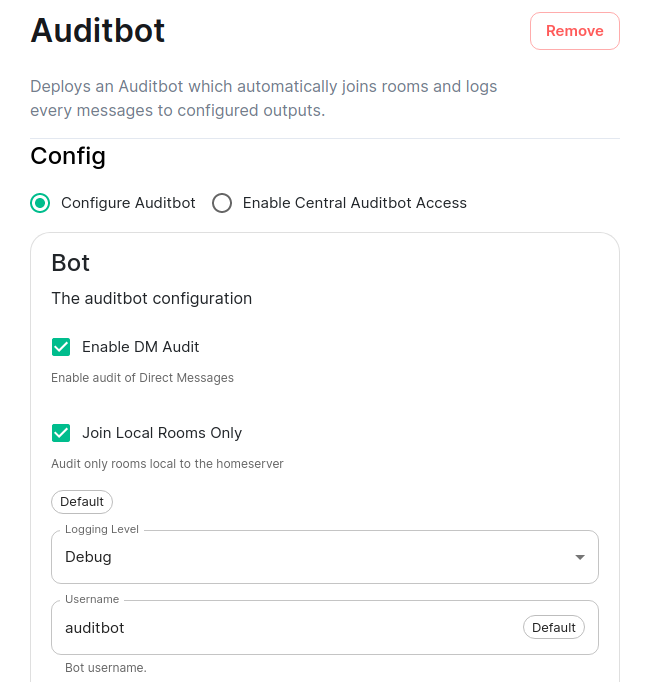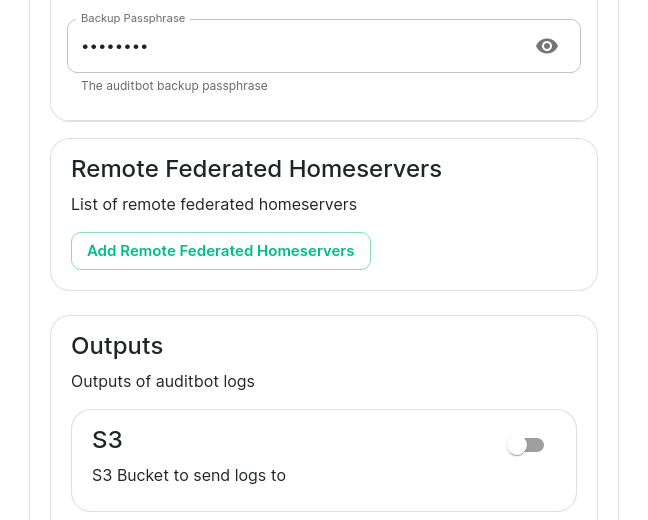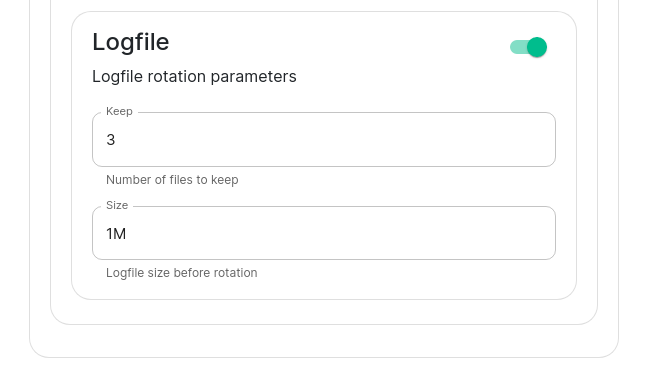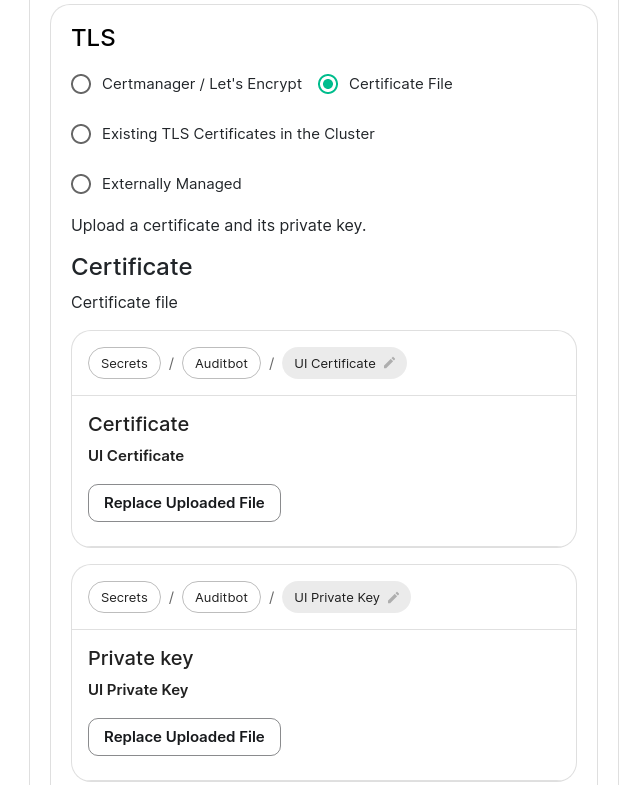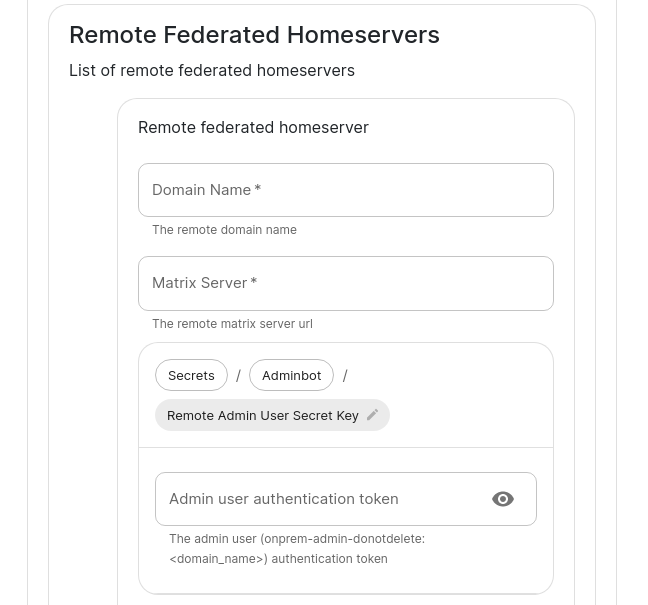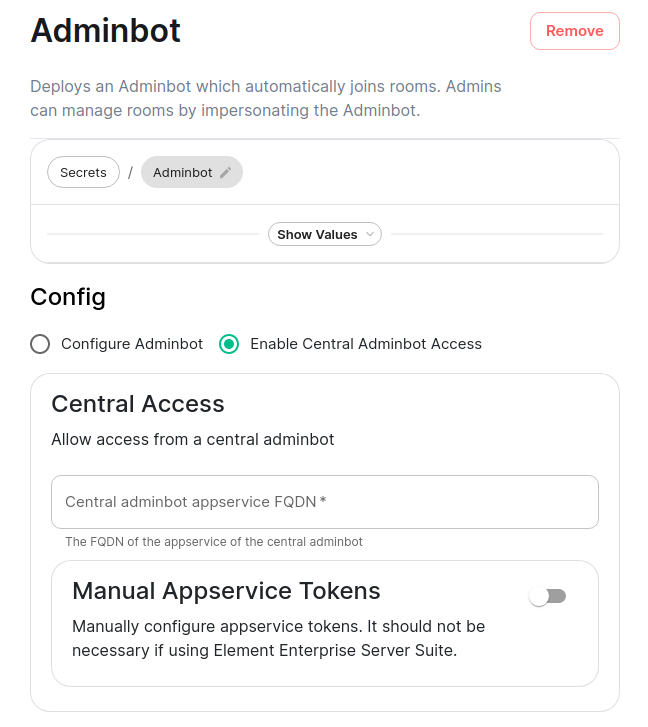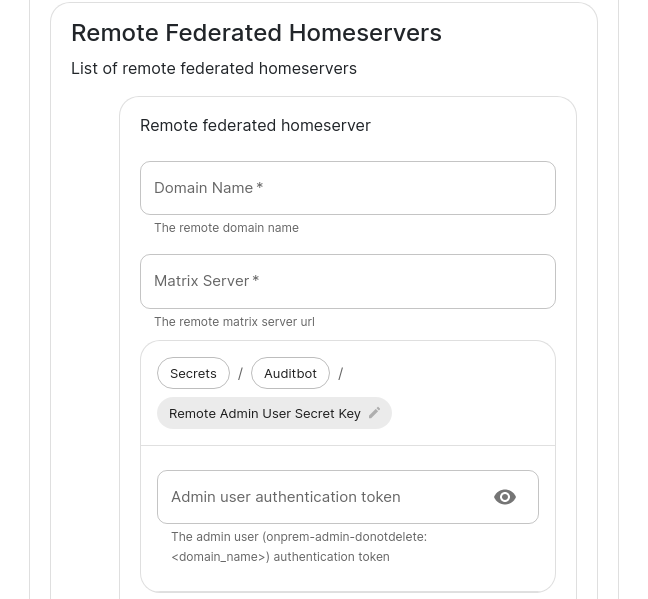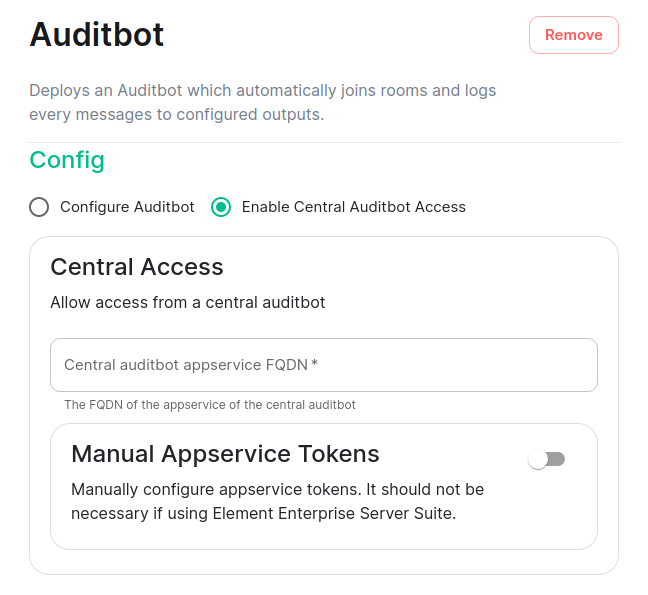Setting up Adminbot and Auditbot
Overview
Adminbot allows for an Element Administrator to become admin in any existing room or space on a managed homeserver. This enables you to delete rooms for which the room administrator has left your company and other useful administration actions.
Auditbot allows you to have the ability to export any communications in any room that the auditbot is a member of, even if encryption is in use. This is important in enabling you to handle compliance requirements that require chat histories be obtainable.
On using Admin Bot and Audit Bot
Currently, we deploy a special version of Element Web to allow you to log in as the adminbot and auditbot. Given this, please do not make changes to widgets in rooms while logged in as the adminbot or the auditbot. The special Element Web does not have any custom settings that you have applied to the main Element Web that your users use and as such, you can cause problems for yourself by working with widgets as the adminbot and auditbot. In the future, we are working to provide custom interfaces for these bots.
Configuring Admin Bot
From the Installer's Integrations page, click "Install" under "Admin Bot"
ForYou will then see the adminbot.ymlfollowing:
Your first choice is to configure adminbot or enable this server as part of a federated adminbot cluster. For most cases, you'll want to select "Configure Adminbot".
Below this, we have a checkbox to either allow the installer, edit the file and ensure the following values are set:
bot_backup_phrase: adminsecret
bot_data_path: /mnt/data/adminbot
bot_data_size: 10M
enable_dm_admin: false
join_local_rooms_only: true
access_elementweb_fqdn: adminbot.airgap.local
Let's discuss them:
bot_backup_phrase: This is the security phrase that will guard accesstoyourparticipateencryptioninkeys.DMDoroomsNOT(roomssharewith 1-2 people) or not.We also have a checkbox to join local rooms only. You probably want to leave this
phrase with anyone. This is required.bot_data_path: This is the directory where the bot's data will be stored.on. If youneedturn it off, the adminbot will try to join any federated rooms that your server is joined to.Moving on, we also have the ability to change the
path,loggingpleaseleveldo,andbutsetforthemostusernamecases,ofyouthecanbot.leaveAfter
thisthis,alone.weIfhaveyoutheare deployingability toKubernetes,setyoutheneed"Backup Passphrase" which is used tocommentgainthis out!bot_data_size: In most cases, you can leave this at 10M, but it does put a limit on the amount of data that can be written by the botaccess to thepath.key - backup
enable_dm_admin:store.ThisTwo
defaults tofalseandsettings thatbehavior means that adminbotwill notjoin DMs. If you want full control of DMs, simply set this totrue. join_local_rooms_only: This defaults totrueand that behavior means that adminbot will only join rooms on your local homeserver.access_elementweb_fqdn: You should set this to a hostname that is resolvable in your environment which will host a special instance of Element Web for logging in. This hostname will need a crt/key PEM encoded key pair and these files willneed to bestored in~/.element-enterprise-server/config/legacy/certsprior to running the installer. In the above example, we have the hostname ofadminbot.airgap.local. This means that the installer expects to findadminbot.airgap.local.crtandadminbot.airgap.local.key~/.element-enterprise-server/config/legacy/certs`"Advanced"directory. If yousection areusingtheLet'sfqdnEncrypt,foryouthedoadminbotnotelementneedwebtoaccessaddpointtheseandfiles.its - certifactes.
verify_tlsThese:settingsOptional.canIfbedoingfoundabyPOCclickingwith"Advanced"self-signedandcertificates,scrollingsetto:thisto0.Defaultsand
tothen:1.
Configuring Audit Bot
From the Installer's Integrations page, click "Install" under "Audit Bot".
ForYou will then see the auditbot.ymlfollowing:
Your first choice is to configure auditbot or enable this server as part of a federated auditbot cluster. For most cases, you'll want to select "Configure Auditbot".
Below this, we have a checkbox to either allow the installer, edit the file and ensure the following values are set:
bot_backup_phrase: auditsecret
bot_data_path: /mnt/data/auditbot
bot_data_size: 10M
join_local_rooms_only: true
enable_dm_audit: false
access_elementweb_fqdn: auditbot.airgap.local
### optional :the S3 bucket whereadminbot to storeparticipate thein auditDM logsrooms #s3_bucket:(rooms #s3_access_key_id:with #s3_secret_access_key:1-2 #s3_key_prefix:people) #s3_region:or #s3_endpoint:not.
###We optionalalso :have thea checkbox to join local logfilerooms settings.only. UsedYou ifprobably s3 bucket is not enabled.
logfile_size: 1M
logfile_keep: 3
Let's discuss them:
bot_backup_phrase: This is the security phrase that will guard accesswant toyour encryption keys. Do NOT shareleave thisphrase with anyone. This is required.bot_data_path: This is the directory where the bot's data will be stored.on. If youneedturn it off, the adminbot will try to join any federated rooms that your server is joined to.Moving on, we also have the ability to change the
path,loggingpleaseleveldo,andbutsetforthemostusernamecases,of the bot.After this, we have the ability to set the "Backup Passphrase" which is used to gain access to the key backup store.
You can also configure an S3 bucket to log to and you can
leaveconfigurethishowalone.manyIflogfilesyoushouldarebedeployingkept and how large a log file should be allowed toKubernetes,growyouto.needBy default, the auditbot will log tocomment this out!bot_data_size: In most cases, you can leave this at 10M, but it does put a limit ontheamount of datastorage thatcanhasbebeenwrittenattached by thebotclusterto(check thepath.storage - settings
join_local_rooms_only:underThisthedefaults"Advanced"totab).trueTwo
andsettings thatbehavior means that adminbot will only join rooms on your local homeserver. enable_dm_admin: This defaults tofalseand that behavior means that adminbotwill notjoin DMs. If you want full control of DMs, simply set this totrue.access_elementweb_fqdn: You should set this to a hostname that is resolvable in your environment which will host a special instance of Element Web for logging in. This hostname will need a crt/key PEM encoded key pair and these files willneed to bestored in~/.element-enterprise-server/config/legacy/certsprior to running the installer. In the above example, we have the hostname ofauditbot.airgap.local. This means that the installer expects to findauditbot.airgap.local.crtandauditbot.airgap.local.key~/.element-enterprise-server/config/legacy/certs`"Advanced"directory. If yousection areusingtheLet'sfqdnEncrypt,foryouthedoauditbotnotelementneedwebtoaccessaddpointtheseandfiles.its - certifactes.
verify_tlsThese:settingsOptional.canIfbedoingfoundabyPOCclickingwith"Advanced"self-signedandcertificates,scrollingsetto:thisto0.Defaults to 1.
Adminbot Federation
On the central admin bot server
CompleteYou will pick "Configure Admin Bot" and will fill in everything from the valuesabove Adminbot configuration instructions, but you will also add Remote Federated Homeservers in this interface:
You will need to fill out this form for theeach providedremote central.ymlserver inthat will join the installerfederation. interface.You Herewill isneed anto explanation ofset the parameters:domain name and the matrix server for each to get started.
adminbot_fqdn: The FQDN whichYou will
bealsotargetedneedbytoremote federated servers asgrab thecentralAdminaudituser authentication token for each server- and
remote_federated_homeservers:specifyAthatlisthere.containingYoueverymayremotegetauditedthisserver. It containswith the followingvariablescommand:run- against
- a
matrix_server:specificURL of the synapse server domain_name: Domain name from parameters.yaml (the server name part of the users mxid)If the server is managed by the installer :generic_shared_secret: The generic shared secret to get from secrets.yamladminuser_token: The token from the admin user, to get viaserver:kubectl get synapseusers/adminuser-donotdelete -n element-onprem -o yaml.It'sYou are looking for the value of the fieldstatus.accessToken.
Then
Ifin theserverappisservice,notyoumanagedcanbyleave Automatically compute theinstallerappservice:tokens - set.
as_token:willTheneed to also get the generic shared secret from that server and specify it here astokenwell.configuredYouoncan get this value from running:kubectl get -n element-onprem secrets first-element-deployment-synapse-secrets -o yaml | grep registrationand looking at theremotevalueappservice file onfor theremote server. hs_token: The as token configured on the remote appservice file on the remote server.adminuser_token: An access token to an user which is server admin.
- a
On the remote admin bot server
CompleteInstead of selecting "Configure Adminbot", you will pick "Enable Central Adminbot Access" and will then be presented with this UI:
You will then specify the access.yml file in the installer interface by providing the fqdnFQDN of the central admin botadminbot server.
central_adminbot_fqdn: The value ofadminbot_fqdnon the central audit bot server
Auditbot Federation
On the central auditbot server
CompleteYou will pick "Configure Audit Bot" and will fill in everything from the valuesabove Auditbot configuration instructions, but you will also add Remote Federated Homeservers in this interface:
You will need to fill out this form for theeach providedremote central.ymlserver inthat will join the installerfederation. interface.You Herewill isneed anto explanation ofset the parameters:domain name and the matrix server for each to get started.
auditbot_fqdn: The FQDN whichYou will
bealsotargetedneedbytoremote federated servers asgrab thecentralAdminaudituser authentication token for each server- and
remote_federated_homeservers:specifyAthatlisthere.containingYoueverymayremotegetauditedthisserver. It containswith the followingvariablescommand:run- against
- a
matrix_server:specificURL of the synapse server domain_name: Domain name from parameters.yaml (the server name part of the users mxid)If the server is managed by the installer :generic_shared_secret: The generic shared secret to get from secrets.yamladminuser_token: The token from the admin user, to get viaserver:kubectl get synapseusers/adminuser-donotdelete -n element-onprem -o yaml.It'sYou are looking for the value of the fieldstatus.accessToken.
Then
Ifin theserverappisservice,notyoumanagedcanbyleave Automatically compute theinstallerappservice:tokens - set.
as_token:willTheneed to also get the generic shared secret from that server and specify it here astokenwell.configuredYouoncan get this value from running:kubectl get -n element-onprem secrets first-element-deployment-synapse-secrets -o yaml | grep registrationand looking at theremotevalueappservice file onfor theremote server. hs_token: The as token configured on the remote appservice file on the remote server.adminuser_token: An access token to an user which is server admin.
- a
On the remote audit bot server
CompleteInstead of selecting "Configure Auditbot", you will pick "Enable Central Auditbot Access" and will then be presented with this UI:
You will then specify the access.yml file in the installer interface by providing the fqdnFQDN of the central audit botauditbot server.
central_auditbot_fqdn: The value ofauditbot_fqdnon the central audit bot server

